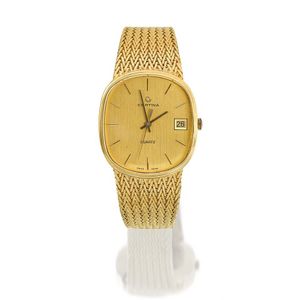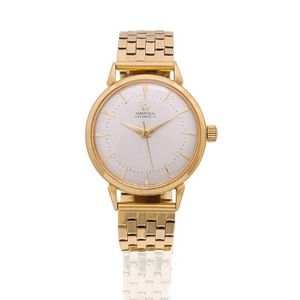Omega Constellation 18ct Gold Automatic Watch
You must be a subscriber, and be logged in to view price and dealer details.
Subscribe Now to view actual auction price for this item
When you subscribe, you have the option of setting the currency in which to display prices to $Au, $US, $NZ or Stg.
- Date Aperture - A date aperture is a cut out section in the face of a watch or clock, displaying the day of the month.
- Basket Weave / Basketweave - Basket weave is a decorative pattern that is often used in textiles, ceramics, furniture and other decorative arts. It is created by actual or simulated interweaving of horizontal and vertical threads or strips to create a pattern that resembles a woven basket.
In textiles, basket weave can be created using various materials such as fabric, yarn, or ribbon. It is often used to create decorative details on clothing, upholstery, and other household items. Simulated basket weave can also be created using ceramic clay, timber or other materials, and it is often used to decorate pottery, tiles, furniture, silver and other decorative objects.
Basket weave patterns can vary in complexity, from simple, straightforward designs to more intricate, elaborate patterns. The size and spacing of the interwoven threads or strips can also be varied to create different effects. Basket weave is often used to create a natural, rustic look and is often associated with traditional crafts and folk art. - Movement - The technical name for the workings of a clock or watch, and does not include the dial or case.
- Circa - A Latin term meaning 'about', often used in the antique trade to give an approximate date for the piece, usually considered to be five years on either side of the circa year. Thus, circa 1900 means the piece was made about 1900, probably between 1895 and 1905. The expression is sometimes abbreviated to c.1900.
- Baton Numerals - A watch that instead of displaying numerals on the face, displays a marker in the form of a baton, or lower case letter "L". Since the baton-like marks are not numerals, the feature is also called baton markers, baton indexes and baton indicators.
This item has been included into following indexes:
Visually similar items

Cartier a lady's 18ct tri-colour gold wristwatch with bracelet ref 2357 case CC714844 Trinity circa 2000, quartz movement, silvered dial, black painted Roman numerals, secret signature at X, blued steel hands, sapphire-set winding Crown, tri-colour gold tw

Vacheron & Constantin An 18ct gold automatic wristwatch with date ref 63780 mvt 571208 case 406563 circa 1960 Cal. K1072 automatic winding movement, fully jewelled, gilt dial, applied triangular indexes, date aperture at 3 o'clock, centre seconds, circular

Certina an 18ct gold bracelet watch with date case 72950268 no 729600468, quartz movement, gilt dial, applied baton numerals, ovoid case, case, dial and movement signed, with an integrated 18ct gold Certina weave bracelet, length 34 mm, overall length 191

Omega An 18ct gold automatic wristwatch circa 1950 Cal. 351 automatic 'bumper' movement, fully jewelled, silvered dial, applied dagger numerals, dauphine hands, centre seconds, circular case with snap-on back, case, dial and movement signed, with an 18ct g
